The Cowen House was constructed in 1854 by Stephen D. Cowen, a prosperous farmer who migrated to Acworth from Virginia in the early 1850s. Originally part of a 1200 acre farmstead, the Cowen House survived the Union occupation of Acworth by General William T. Sherman in 1864 and now sits on approximately one-half of an acre, the remainder of the land having been sold off after Stephen Cowen’s death in 1900, when the property was divided among his heirs. In 1918, the house was sold out of the Cowen family and is presently owned by the Acworth Society for Historic Preservation.
The Cowen House is an excellent example of a pre-Civil War plantation plain-type structure, a house style that is a version of what is more commonly referred to as an I-house: a two-story house usually two rooms wide and one room deep with a side-gabled roof structure. The I-house was popular because its balanced, symmetrical fade appealed to an increasing interest in classical architecture and was viewed by farmers as a symbol of economic attainment.
Placed on the National Register of Historic Places in 2001, the Cowen Farmstead was also designated as an Acworth Historic Landmark in 1998.




